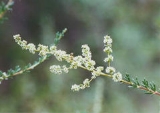
Adenostoma
Encyclopedia
Adenostoma is a genus of shrubs containing only two species: Adenostoma fasciculatum
(Commonly known as Chamise), and Adenostoma sparsifolium
(Red shank). Both are native to coastal California
and Baja California
, while A. fasciculatum is also native to California's Sierra Nevada mountains.
Both species in this genus feature stiff, linear leaves arranged alternately or in clusters along stems with shredding bark. Flowers form on a panicle
, are cream to white and, as in all members of the rose family
, have hypanthia
.
Adenostoma fasciculatum
Adenostoma fasciculatum is a flowering plant native to California and northern Baja California. This shrub is one of the most widespread plants of the chaparral biome.-Description:...
(Commonly known as Chamise), and Adenostoma sparsifolium
Adenostoma sparsifolium
Adenostoma sparsifolium, Redshanks or less commonly, Ribbonwood, is a multi-trunked tree or shrub native to dry slopes or chaparral of Southern California and northern Baja California.-Description:...
(Red shank). Both are native to coastal California
California
California is a state located on the West Coast of the United States. It is by far the most populous U.S. state, and the third-largest by land area...
and Baja California
Baja California
Baja California officially Estado Libre y Soberano de Baja California is one of the 31 states which, with the Federal District, comprise the 32 Federal Entities of Mexico. It is both the northernmost and westernmost state of Mexico. Before becoming a state in 1953, the area was known as the North...
, while A. fasciculatum is also native to California's Sierra Nevada mountains.
Both species in this genus feature stiff, linear leaves arranged alternately or in clusters along stems with shredding bark. Flowers form on a panicle
Panicle
A panicle is a compound raceme, a loose, much-branched indeterminate inflorescence with pedicellate flowers attached along the secondary branches; in other words, a branched cluster of flowers in which the branches are racemes....
, are cream to white and, as in all members of the rose family
Rosaceae
Rosaceae are a medium-sized family of flowering plants, including about 2830 species in 95 genera. The name is derived from the type genus Rosa. Among the largest genera are Alchemilla , Sorbus , Crataegus , Cotoneaster , and Rubus...
, have hypanthia
Hypanthium
A hypanthium is a floral structure consisting of the bases of the sepals, petals, and stamens fused together. Its presence is diagnostic of many families, including the Rosaceae, Grossulariaceae, and Fabaceae...
.

